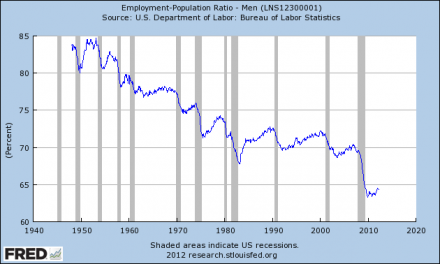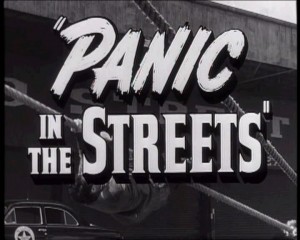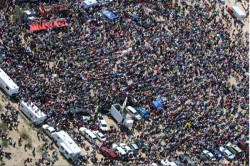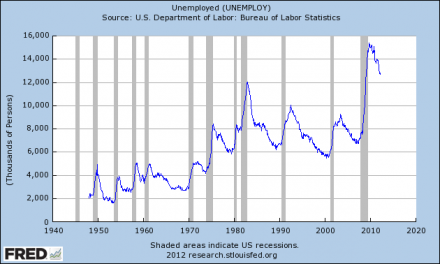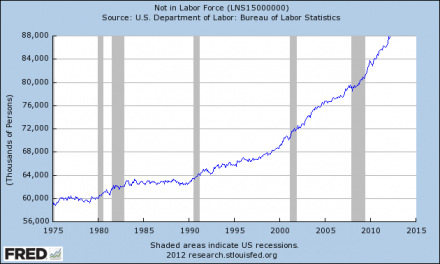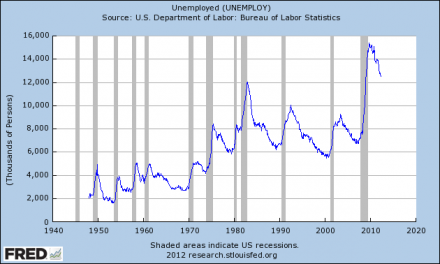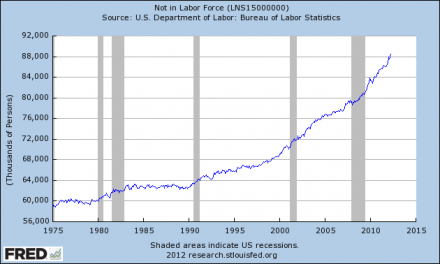 This economic decline has been really hard on everyone, but it has been particularly hard on American men. During the last recession male employment dropped like a rock and it has not recovered much at all since then. That is why many referred to the last recession as a “mancession”. Industries where men are disproportionately represented such as construction and manufacturing have really been hit hard in recent years. In the old days, you could take a high school education down to the local factory and get a job that would enable you to live a middle class lifestyle and support a growing family on just that one income. Sadly, those days are long gone. Today, American men live in a world where their labor is not really needed. Wages are falling because almost any worker can be easily replaced by the vast pool of unemployed American workers that are currently searching for work, and a lot of big companies are shifting labor-intensive jobs overseas where workers only make a small fraction of what they make in the United States. American workers (especially those without much education) are considered to be expensive liabilities in a world where labor has become a global commodity. So the percentage of working age American men that have jobs is likely to continue to decline and wages are likely to continue to stagnate as well.
This economic decline has been really hard on everyone, but it has been particularly hard on American men. During the last recession male employment dropped like a rock and it has not recovered much at all since then. That is why many referred to the last recession as a “mancession”. Industries where men are disproportionately represented such as construction and manufacturing have really been hit hard in recent years. In the old days, you could take a high school education down to the local factory and get a job that would enable you to live a middle class lifestyle and support a growing family on just that one income. Sadly, those days are long gone. Today, American men live in a world where their labor is not really needed. Wages are falling because almost any worker can be easily replaced by the vast pool of unemployed American workers that are currently searching for work, and a lot of big companies are shifting labor-intensive jobs overseas where workers only make a small fraction of what they make in the United States. American workers (especially those without much education) are considered to be expensive liabilities in a world where labor has become a global commodity. So the percentage of working age American men that have jobs is likely to continue to decline and wages are likely to continue to stagnate as well.
For many men, a long-term bout with unemployment can almost be worse than a major illness. It can be really hard to feel like a man when you don’t have a job. Men often see themselves as filling the “provider” role, and when they aren’t providing for their families self-esteem can fall through the floor. It is easy to feel worthless when there is no money coming in and your wife and your kids are looking at you with worry every single day.
As you read this, there are millions upon millions of unemployed men sitting at home with a glazed look in their eyes. When you talk with these men, many of them seem as though the life has been sucked right out of them.
As I wrote about recently, when you cannot find a job month after month after month people start to look at you differently. Some start to look at you with pity in their eyes, and others start to look at you with disgust in their eyes.
Most Americans don’t really understand how much the economy has fundamentally changed, and many of them still believe that it shouldn’t be too difficult to find a job in “the greatest economy on earth”.
But things have changed. If you don’t have a college education or some highly specialized skills then it is going to be exceedingly difficult to get a good paying job in this economy.
Unfortunately, finding a job is not going to be getting any easier. Times are hard now, but they are going to be getting a lot harder.
The following are 16 signs that this economic decline is sucking the life out of the American male….
#1 During the last recession, men lost twice as many jobs as women did.
#2 According to the Economic Policy Institute, the “real entry-level hourly wage for men who recently graduated from high school” has declined from $15.64 in 1979 to $11.68 last year.
#3 During the recent economic downturn millions of men saw their family finances get absolutely destroyed. According to the Federal Reserve, the median net worth of families in the United States declined “from $126,400 in 2007 to $77,300 in 2010“.
#4 As you can see from the chart below, in the 1950s there were times when nearly 85 percent of all working age men had a job. Sadly, that number has stayed below 65 percent since the end of the last recession….
#5 More unemployed fathers than ever are staying at home with the kids. Over the past decade the number of “stay at home dads” has doubled.
#6 Prior to the recession, women accounted for approximately 45 percent of the workforce. Now, they account for 49.4 percent of the workforce.
#7 According to one new survey, 23 percent of all small business owners in America have gone for more than a year without pay. More than half of all small business owners are men.
#8 The decline in manufacturing jobs has had a disproportionate impact on men. Back in 1940, 23.4% of all American workers had manufacturing jobs. Today, only 10.4% of all American workers have manufacturing jobs.
#9 More than half of all middle management jobs in America are now held by women.
#10 More than half of all health care jobs in America are now held by women.
#11 American men love to watch television. But because of harsh economic conditions more families than ever are eliminating cable television service. According to one survey, a whopping 6.9 million American homes cancelled cable service last year.
#12 According to the New York Times, approximately 57 percent of all Americans that are currently enrolled in college are women.
#13 According to one study, between 1969 and 2009 the median wages earned by American men between the ages of 30 and 50 dropped by 27 percent after you account for inflation.
#14 According to another study, “young, urban, childless women” make more money in America today than young, urban, childless men do.
#15 According to CNN, in the United States today men in the 25 to 34 age bracket are nearly twice as likely to live with their parents as women the same age are….
The number of adult children who live with their parents, especially young males, has soared since the economy started heading south. Among males age 25 to 34, 19% live with their parents today, a 5 percentage point increase from 2005, according to Census data released Thursday. Meanwhile, 10% of women in that age group live at home, up from 8% six years ago.
#16 Our system often treats elderly American men like absolute trash. Just check out what happened to one elderly veteran up in Montana recently….
Warren C. Bodeker is an 89 year old World War II Army Airborne combat veteran and war hero, living in Montana, who is being thrown off of his own land and thrown out of his own house, by Montana Federal Bankruptcy Trustee, Christy Brandon, with the approval of the U.S. Bankruptcy Court in Montana. And to make matters worse, Warren’s wife Lorna just died of cancer this past year, and is buried there on their land, right next to the house. Warren had planned to live there till he died and then be buried right next to his wife, there on their property at 11 Freedom Lane, in the town of Plains, Montana, but now, not only is he being forced off his land, he is being forced to exhume his wife’s body and take her with him.
As the ability of men (and women) to take care of their families continues to decline, the middle class continues to shrink rapidly.
Most Americans continue to expect our economy to be able to bounce back to where it was before, but the truth is that the U.S. economy is in the midst of a long-term decline.
We are heading for an absolute economic nightmare, and we desperately need to come together as a nation and find some real solutions.
Unfortunately, our nation is becoming more divided than ever, and most of our politicians are proposing that we continue to do the exact same things that got us into this mess.
So what do all of you think about “the mancession” and what this economic decline is doing to the American male? Please feel free to post a comment with your thoughts below….
